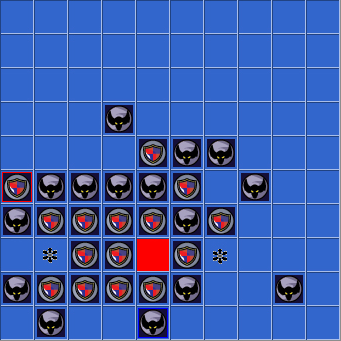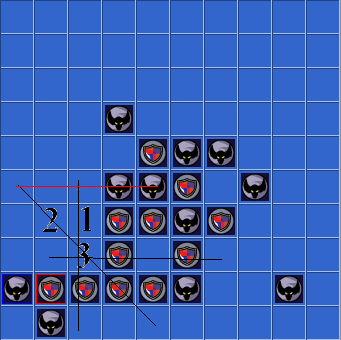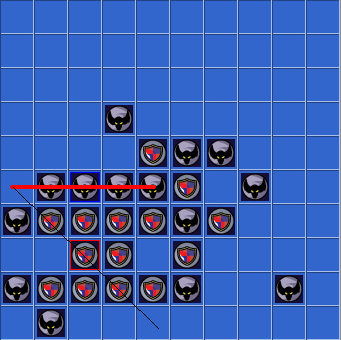Cellblock

|
This page is under construction |
|---|---|
| Article being rewritten |
| Cellblock | |
|---|---|
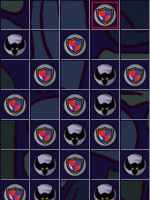
| |
| ID # | 216 |
| World | Darigan Citidel |
| Category | Brain Busters, Card & Board, Puzzle |
| High Scores | |
| Game Page | |
Cellblock is a strategy board game similar to Gomoku. It is played in the dungeons of Darigan Citadel by Master Vex, who created the game and challenges his prisoners and promising freedom should they beat him (no one has), but merely lies to pass the time with them. It was released on January 28, 2003.
Gameplay[edit]
Users play against a computer to be the first to line up an unbroken row of five pieces horizontally, vertically, or diagonally. To progress through the game, users challenge the opponents by paying a challenge fee with Neopoints, and beat successively harder opponents in a "best of x" style contest. As the opponents get harder, the number of rounds it takes to beat them in raises with it. Once all opponents are defeated in the first tournament, a new tournament is started with more difficult opponents. If a user loses against any opponent, they can face off against them again, but need to pay the challenge fee.
In the first tournament four pieces of both players are set in an "X" in the middle of the board, and users can only place new game piece next to another game piece on the board. In Tournament 2-10, pieces can be placed anywhere on the game board, and in Tournament 11 and beyond, zero game pieces on the board, and rock hazards are placed to block gameplay, requiring the user to use a different strategy.
A reward of 4 times the Neopoints used to challenge an opponent is given for each opponent defeated, with a maximum of 5000 Neopoints each day (similar to other games such as Pyramids and Scarab 21). Upon reaching this max, Cellblock can no longer be played until the next day. Reaching this max is will take several games of play to reach, but after playing up to tournament 11, the max can be reached in just a few rounds.
| Tournament 1 | Tournament 2 - 10 | Tournament 11 and beyond |
|---|---|---|
|
| Prisoner One - Clop |  |
Prisoner Two - Barallus | 
|
| Prisoner Three - Squire Meekel |  |
Prisoner Four - The Yellow Knight | 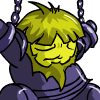
|
| Prisoner Five - Number Five |  |
Guard One - Galgarrath | 
|
| Guard Two - Haskol |  |
The Warden - Master Vex | 
|
Playing Tips[edit]
- Try to form an unblocked "three" (three in a row) each turn.
- Never let the opponent keep an unblocked three.
- If you have an unblocked four, you can not be stopped from winning.
- Try to cluster your threes in clumps to make automatic threes and blocked fours.
- A good trick is to make threes in such a way that you make three(s) in other directions - two or more unblocked threes means that you will make an unblocked four and there is nothing they can do.
Master the basic techniques and understand that the AI makes the same mistakes every time and you can soon develop a pattern to thrash this player without really thinking.
Secret Threes[edit]
As well as having three in a row, something that is more subtle but just as good is 1-space-2 this is also considered a three but is slightly more powerful as another stone at either end or the middle could make it a four.
Even better but very hard to get is 1-space-1-space-1. It's harder to spot (for you) and can easily become an unblocked four.
Quick win solution[edit]
- Note: This is not the only possible solution to win the game.
This guide is aimed at players of Cellblock who wish to overcome the more challenging levels or just generally improve their gameplay. Reading this guide should grant you at least enough knowledge to win the bronze.
The screenshot (to the right) shows the final position that should be your aim in every game you play. The player can choose between two possible locations and no matter where the computer blocks the player is going to win.
This didn't happen by chance but by planning, cunning and playing to win. To know the usual strategy of the AI can also be helpful.
If you have read the playing tips section on the Cellblock page you will have a general idea what we are going to do, namely to set up a winning situation that the computer can not block.
In this guide you will see how to apply those ideas into a playing plan and thrash your way to a (small) fortune.
The game is still not going to be "easy" but it will be simpler to get at those all elusive victories (especially later when the AI stops throwing the game).
You will be able to learn, for example, that victory is often gained in the first three or four moves of a game.
You will see the very game that got me this screen shot and for the main part you should be able to repeat the game as the AI can be astoundingly thick at times and easily predictable.
The rule is simple: get him on the ropes and keep him there. Force his move so you are playing both sides in your favour.
The opening nine moves are shown here but what I will explain is not the where (you can see that) but the reason fot the particular placements so that you will understand the reasoning and be able to apply it for yourself.
The first big hint is that the computers second move is always the same and always very very weak. So we get two of the three moves needed to set up a win to start with.
You go first and create a row of three from your two. At higher levels you will not get this start so practice now.
The computer blocks. It is also possible that the computer will move somewhere else and give you the game.
You do not extend your "dead three" into a four but make a rather strange move (you block the other guy to create a 1-gap-gap-1). A strong move would be to attempt a three back at you but the computer (robbed of it's only obvious three making) makes a weak move and blocks the three again at the other end. It nearly always does this.
From there we are able to convert our strange move into a row of four with a stone missing: 2-gap-1. We do this not to get the four (although a quick game would be nice) but to misdirect the computer into blocking while we set up a new two-diagonal that we can make into a three in making it a three we set the same up again.
The computer rightly blocks our potential four (or next turn the game would be over).
However we have no interest in the potential four as we move on to that three diagonal down and left. In my game the computer blocked me at the top (it usually does) and so I extended three to a four and force the computer to place a stone at the very bottom of the screen. This gives me a foundation to build new threes on and is effectively a "free move" as control passes back to me without the computer having a say in the direction of the game.
From here I make another 3 and this sets up another three nicely. Each time we make him play block the player he can't do anything to further his win potential. We use this to build our win.
Move eight is another three (that places a stone for later). Move nine places another stone for later and forces the computer to again place a useless stone as a block.
What we have done is to prepare the game for our win. If you play the same moves as this you should almost always end up in the same situation but it is the idea behind the moves that makes them so good.
Now the first danger opens up - (Indicated by the red line) the only chance at a win the computer gets. Always be careful not to get the order wrong or instead of beating the computer you will allow it to win.
Move three of this next set (see picture) will set up the win.
First we make a diagonal 3 which the computer will block with a stone on the red line. Then we extend it to make another four (forces the computer to play below the red line). That force gave us another effective free move.
This is when we place the stone on the square marked "3". We have a top to bottom 3 a diagonal 3 and a 2-space-1 which is just as good if not better.
From here on it is win or loose as the computer will make a four and threaten to force you to give up the advantage. If he does that you have no hope of winning. However keep your cool and win the day.
Now we close in for the kill. Notice we have a three that forms a possible five (winning row) that overlaps with the danger line. We set this up quite deliberately. We block and make a four.
Now you have done something very clever. You killed the threat and set up a four that the computer must block or lose the game to you. While he's blocking the four he can't be stopping that 2-gap-1.
So you can then place a stone in the gap of your 2-gap-1 and bingo - four unblocked in a row. Now two squares can be used to convert that to a winning five and the computer has only one move - where-ever he goes you go the other and win.
The game is yours. Well done.
This was achieved with a little insight and a little forward planning. Every game you play can be this easy. Remember what we did was to play in such a way that we forced the computer to make moves we wanted it to, setting ourselves up for new three's and fours every turn while building a critical mass to make a winning set-up.
External Links[edit]
- NeoDeck: Master Vex
- Neopets TCG: Master Vex, Locked in the Dungeon
| Darigan Citadel Games |
|---|
